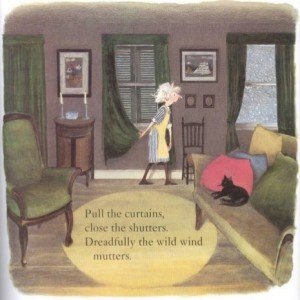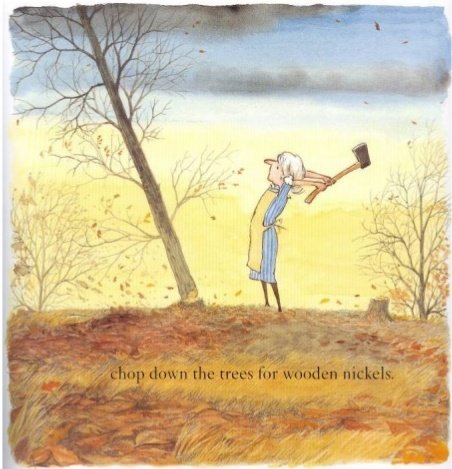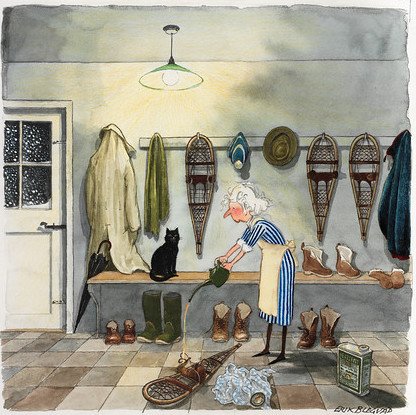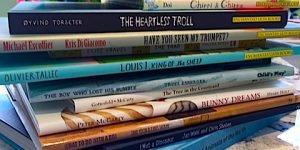Years ago, I used to work in an independent bookstore. Of the many customers who came my way, most have faded into the past. Sandy Muldrew is one of the memorable few. Not only have we remained friends, he shared, and continues to share, my passion for beautifully illustrated picture books. Although our (superb) tastes frequently overlap, our collections diverge, and so I thought – why not spread the passion around and invite him to write about one of his favourites? I am pleased to say, it worked! And so, I will turn this blog over to Sandy for the first, (and hopefully not the last), guest post:
When Donna asked me to write a guest blog for 32 Pages, I wasn’t sure if I had a worthy book that she had not yet touched upon. Recently, I have been relying solely on her excellent recommendations to add to my collection of illustrated treasures (and subtract from my bank account). But then I remembered a perfect candidate – it’s one of my seasonal favourites – Hurry, Hurry, Mary Dear. While not exactly a children’s book, it is more of a charming poem illustrated with mirthful joy, written and illustrated by N.M. Bodecker in 1975 and then re-illustrated as a tribute by Erik Blegvad in 1997. They were two Danish expats and lifelong friends who shared an art studio in Connecticut. And this is where the poem itself takes place – on a farmhouse in New England – which is appropriate because the heroine of the piece embodies the pioneering spirit of Plymouth Rock. In fact, despite being thin as a rail, she is able to accomplish more in one day than the rest of us could hope to achieve in one year.
The poem begins innocently enough with Mary’s layabout husband issuing the first of his many edicts: “Hurry, hurry, Mary dear, fall is over, winter’s here,” he yawns from the comfort of his warm bed. “Not a moment to be lost, in a minute we get frost! In an hour we get snow! Drifts like houses! Ten below!” At this, from dawn’s early light to dusk and night, we witness Mary’s super-human endurance as she completes one impossible task after another. All the while, she shows the patience of a saint as she is put through the paces by the constant commandments issued by her unseen spouse (supposedly from somewhere deep within the warm house – far, far away from draughts). “Pick the apples, dill the pickles, chop down trees for wooden nickels. Dig the turnips, split the peas, cook molasses, curdle cheese.” As the harvesting becomes increasingly ridiculous (cook molasses??), it is all offset by the wonderfully humourous illustrations of the scrawny Mary with her sharp nose, tiny feet, and ever-present apron and black stockings. She wields her axes and shovels like Hercules taking on the Hydra and Cerberus.
“Churn the butter, smoke the hams, can tomatoes, put up jams. Stack the stove wood, string the beans, up the storms and down the screens.”
Through all of this – as the wind picks up, the leaves fall, the trees bend, and snowflakes appear – our poor Mary, flushed and frazzled, seems to age twenty years. Her nose reddens, her hair becomes disheveled, and her back bends like an exhausted hunchback. As day turns to night, the impending snowstorm descends upon the house with it’s full fury. Mary finally retreats indoors but her day is far from done.
“Pull the curtains, close the shutters. Dreadfully the wild wind mutters. Oil the snowshoes, stoke the fires. Soon the roads are hopeless mires. Mend the mittens, knit the sweaters, bring my glasses, mail my letters.”
Dutifully she scurries about and obeys the offscreen patriarch who we finally see again – stuffed into his rocker with slippered feet, pillow and pipe. “Toast the muffins, hot and sweet and good for me. Bake me doughnuts, plain and frosted…What, my dear? You feel exhausted? Yes, these winters are severe! Hurry, hurry…” With that, like the tea, she finally reaches her boiling point and dumps it all over his head “…Mary dear.” Perfect!
I love this poem not only for it’s humour but also for it’s comforting notion of winter hibernation. Thankfully none of us have to go through the Herculean efforts of Mary, but, still, there is always autumnal work to be done to ready one’s house for the season’s first snowfall. Is there anything more comforting than getting all the leaves raked, the hoses put away, the garden dug, and the windows washed before the first flakes fly? As the furnace kicks in and you get that whiff of singed dust from it’s summer disuse, you can’t help but feel snug and smug. Sporting slippers and sweater, you survey your realm with satisfaction (from the warmth of your indoor sanctuary). You brew a pot of tea, nibble on some biscuits, settle into your corner wingback, and open up a good book. And, all the while, the wild wind mutters. There is a primitive pleasure in this. It  hearkens back to the first time we crawled into a cave to escape the elements. Despite the absence of biscuits (not yet invented), we, nevertheless, overcame the cold and the wet by lighting a fire, huddling together, and telling stories. Then, as now, we are still lulled to sleep as the muffled storm rages outside. While, today, it is much easier to keep warm and dry, the sense of satisfaction persists. We still take great comfort in retreating indoors and shutting the door on the cold – and that is wonderfully conveyed in a poem like Hurry, Hurry, Mary Dear. Every fall, I reread it to experience, once again, that feeling of gezelligheid. I hope you will seek out this book and when the snows arrive next November (or possibly October…), you too, will be entertained and warmed by it.
hearkens back to the first time we crawled into a cave to escape the elements. Despite the absence of biscuits (not yet invented), we, nevertheless, overcame the cold and the wet by lighting a fire, huddling together, and telling stories. Then, as now, we are still lulled to sleep as the muffled storm rages outside. While, today, it is much easier to keep warm and dry, the sense of satisfaction persists. We still take great comfort in retreating indoors and shutting the door on the cold – and that is wonderfully conveyed in a poem like Hurry, Hurry, Mary Dear. Every fall, I reread it to experience, once again, that feeling of gezelligheid. I hope you will seek out this book and when the snows arrive next November (or possibly October…), you too, will be entertained and warmed by it.
(P.S. Watch for Mary’s constant companion – the ever-present black cat. It appears in every scene – sometimes in the foreground, often in the background, and once in shadow only.)
Review by Sandy Muldrew
Hurry, Hurry Mary Dear written by N.M. Bodecker, illustrations by Erik Blegvad. This edition published by Margaret K. McElderry, 1998














